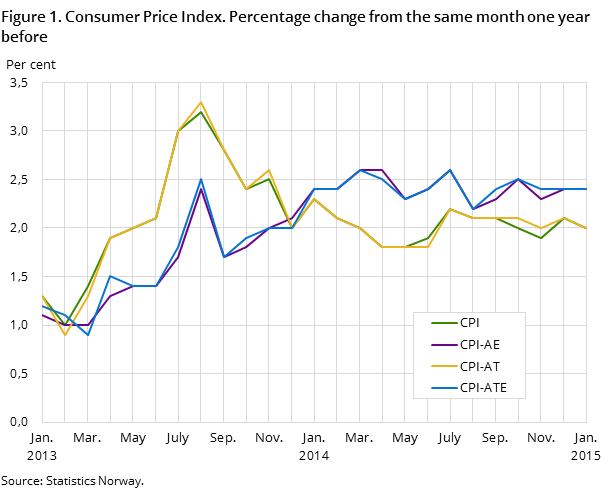Content
Published:
This is an archived release.
Sales activity on clothing pulled CPI down
The Consumer Price Index (CPI) fell 0.1 per cent from December to January. The year-to-year growth in the CPI was 2.0 per cent in January, while the CPI-ATE growth was 2.4 per cent in the same period.
| Monthly change (per cent) | 12-month rate (per cent) | Index | |
|---|---|---|---|
| December 2014 - January 2015 | January 2014 - January 2015 | January 2015 | |
| CPI All-item index | -0.1 | 2.0 | 137.8 |
| Food and non-alcoholic beverages | 0.9 | 2.4 | 129.0 |
| Housing, water, electricity, gas and other fuels | 0.7 | 2.0 | 171.7 |
| Transport | 0.1 | 2.0 | 148.8 |
| Recreation and culture | -0.4 | 2.5 | 121.0 |
| Clothing and footwear | -7.4 | -2.7 | 51.1 |
| CPI-ATE (july 1999 = 100) | -0.1 | 2.4 | 128.6 |
| CPI by delivery sector | |||
| Other consumer goods produced in Norway | -0.1 | -0.1 | 163.0 |
| Imported consumer goods | -0.9 | 1.3 | 91.1 |
| Other services with wages as dominating price factor | 0.5 | 3.5 | 213.4 |

The CPI was 137.8 (1998=100) in January 2015, compared to 135.1 in January 2014, which corresponds to a year-to-year growth of 2.0 per cent.
Monthly change: strong sales activity on clothing
The CPI fell 0.1 per cent from December 2014 to January 2015, mainly due to widespread sales activity on clothing. Prices fell 8.3 per cent within that group last month. Lower prices on clothing are normal for January, and this year’s figure is in line with the figures for previous years. Airfares went down 14.2 per cent from December to January, which is not unusual, though slightly less than in the same period last year. Package holidays are measured every quarter, and showed a price decline of 5.6 per cent.
Increased prices of food and non-alcoholic beverages were the most important factor dampening the decrease in the CPI. These prices combined rose 0.9 per cent last month. In the same period, imputed rentals went up 0.7 per cent, and prices of cars 1.5 per cent.
Year-to-year growth: higher rents and more expensive transportation
The CPI rose by 2.0 per cent from January 2014 to January 2015. Imputed rentals for home owners, with an increase of 2.4 per cent, was the month’s single most important factor in the year-to-year growth in the CPI. Transport services had a price increase of 10.1 per cent, and food-prices rose 2.2 per cent in the same period.
The year-to-year growth in the CPI was mainly dampened by lower prices on fuels and clothing. Petrol prices, both gasoline and diesel fell nearly 8 per cent from January 2014 to January 2015, while prices on clothing declined 3.5 per cent in the same period.
Change in the year-to-year growth: electricity prices pull growth up
The year-to-year growth in the CPI decreased from 2.1 per cent in December to 2.0 per cent in January. The main contributor to the fall was the price development of clothing. These prices fell more than 8 per cent from December 2014 to January 2015 compared to a 5 per cent decline from December 2013 to January 2014. The year-to- year growth in the CPI-ATE was 2.4 per cent in January, unchanged from December.
New weights and items in the CPIOpen and readClose
The weights in the CPI are updated in January each year based on the national account measures on household consumption. The sample of goods and services in the CPI are also updated in January each year. See The weights in the CPI. As of January 2015, CPI is no longer labelled «per 15». However, data collection periods and statistical methods have not been changed. Also from the same time, Financial Intermediation Services Indirectly Measured (FISIM) has been taken out of the CPI.
Contact
-
Statistics Norway's Information Centre
E-mail: informasjon@ssb.no
tel.: (+47) 21 09 46 42
-
Konsumprisindeksen
E-mail: konsumprisindeksen@ssb.no
tel.: (+47) 62 88 56 34
-
Camilla Rochlenge
E-mail: camilla.rochlenge@ssb.no
tel.: (+47) 40 90 23 72
-
Kjersti Nyborg Hov
E-mail: kjersti.nyborg.hov@ssb.no
tel.: (+47) 40 90 23 63
-
Gunnar Larsson
E-mail: gunnar.larsson@ssb.no
tel.: (+47) 40 90 26 79
-
Trym Kristian Økland
E-mail: trym.okland@ssb.no
tel.: (+47) 46 81 09 15
